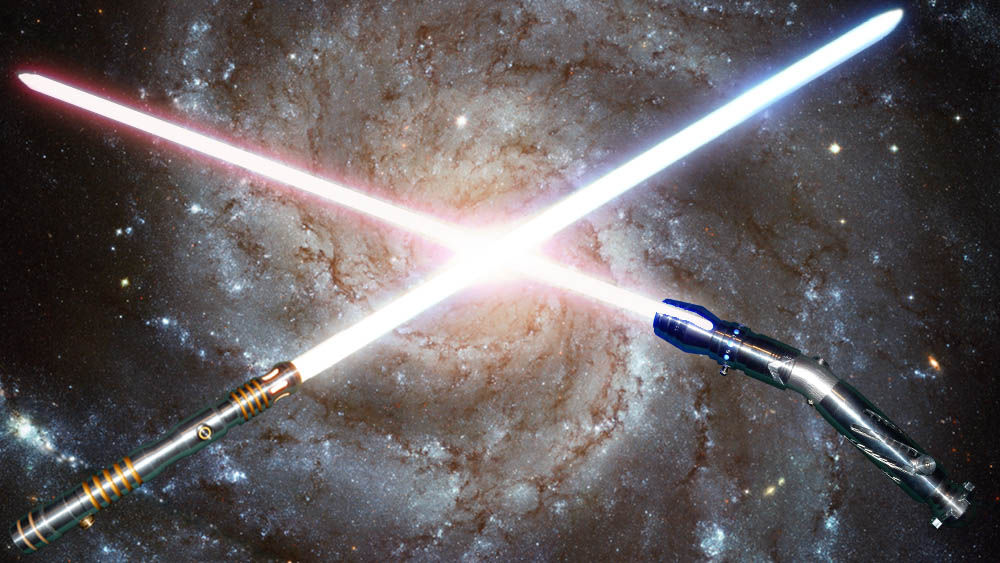Lightsabers
How and Why

The lightsaber is an elegant weapon of a more civilized time. That is today's belief, but what is it really? It is a hand held weapon of melee range that can be as dangerous to the user as it is to the opponent if used by the unskilled. Let's define the weapon more fully. It has an energy based "blade" that exhibits the physical properties of light, heat, cutting ability, a limited length, a physicality resistance like a steel blade, and resistance to motion/inertia but without a physical mass. It must have a power source, a control mechanism, a beam generating apparatus, a means of focusing the beam, an emitter, a grounding plane and a casing to hold the whole thing together.
All will make sense as we progress through our explanation but first we need to address Star Wars early background of the lightsaber. According to the storyline, the Sith invented the "forcesaber", a type of proto-saber that channeled the darkside energy into a blade using special crystals and Sith alchemy. It also had to use a large external power source initially, but according to legend, the Sith also invented a power source small enough to power the lightsaber integrated into the housing as opposed to a backpack or belt power cell. The forcesaber also supposedly contaminated a Jedi to the darkside just by touching or handling the weapon. This may be all well and good but why does the lightsaber not require said alchemy to work also? How come a lightsaber does not turn a Sith to the lightside? A lightsaber is just a highly calibrated esoteric tool in both sides arsenal. In our opinion, the Sith merely have a much better PR program, even though they are supposedly a secret organization. Much like other alphabet agencies, they have a secretive and sinister modus operandi that inflates their egos and reputations. Possible SITH acronym, "Sinister Institute Through Hate".
In order to understand the how's and why's of lightsaber handling and performance, one must look at where they came from. No one knows for sure but if we look at the topic from an engineering perspective, we may be able to get a handle on it. Let's go back to the ancient beginning days of space travel, long before there was faster than light travel. The single biggest danger to space travel short of blowing up was impact and piercing damage from debris, micro meteors and other things that would impact your ship at high velocities, causing all kinds of problems from little holes going right through your ship and personnel to being vaporized if the object was big enough. Terribly annoying. The big problem was, what to do to avoid being pulverized upon impact.
The first solution at the lower speeds was to increase the ships effective armor. This does two things, one it helps stop the lethal impacts of space debris and acts to mitigate harmful radiation. It also adds physical protection to opposing weapons. The drawback, increased mass with the resulting need for increased power for maneuvering and the enormous fuel expense. This can be somewhat mitigated by using economy of size but even that has diminishing returns. The need for a force field for navigation was quickly becoming paramount to faster space travel.
All advanced societies have in their literature science fiction. One having been, force fields or energy shields. Some bright engineer finally got one to work, but it was surely a massive energy hog, able to only be generated on the most massive of ships because of its huge power requirements. So, how would an energy shield work? We will use various descriptions using the Star Wars ethos for reference. In reference to the weapon it self, we will not go into great detail of it's manufacture or esoteric meaning as relating to the Jedi Order, we will be looking at the mechanics of the blade proper.
The energy shield has the unique property of becoming a de-facto physical solid. But what is a "solid". When one looks at physical matter at the atomic and sub-atomic levels, it is mostly space, that between protons, neutrons and especially electrons. The size of the atom is the outer most electron shell, not counting the various forces or bonding aspects. So, if matter is mostly space and matter is really just energy in a different form, then there must be a way to make energy create the associated "forces" of matter to create a synthetic solid out of energy. The forces being the strong force, the weak force, electromagnetism and gravity of course and these forces are what we at the macro world level sense as solid matter. Once that was figured out, it just boiled down to how much power you could use and control to create your synthetic force field/solid.
An energy shield size and shape would be defined by several aspects in harmony, the amount of power available, how fine of a focus, frequency modulation and grounding plane shape and placement. Grounding plane shape and placement is the real decision maker of field shape. If we were to look at the Gungan's beast carried energy shield when they went to battle the Trade Federations battle droids on Naboo, the field generator fired straight up to a fixed height and then spread out spherically to the ground, making a hemispheric shield. The extension distance would be governed by the amount of power and frequency control, then it naturally tries to seek its grounding plane to connect the flow of the circuit. Most energy tries to conform to a spherical shape and in this instance; it is halted at the halfway point because of the grounding plane. So the device is carried by the beast of burden but once in place, a simple grounding rod would suffice to make the earth in general, the grounding plane, making it a hemisphere.
Another example of a spherical shape would be the on-board shields of the rolling destroyer droids. The generator could be placed on top of the droid, keeping the emitter protected and out of the way, the beam would shoot up to it's predetermined height and naturally come down to it's spherical shape as dictated by the grounding plane on the bottom of the droid. Also, with the Gungan's hand held battle shields that mimics a medieval knights shield, the beam originates in the middle and continues to the rim of the shield which is the grounding plane. Hence making a "flat" shield, but again, the grounding plane really defines the shield shape.
Now that we have seen some of the shapes that the energy shields can produce, how to apply them to a space ship. The very first one, the one up front would be the navigation shield. It would potentially be the most powerful and strange looking shield on the ship. The best shape would be an elongated cone to reach out as far as possible in front of the ship to deflect the incoming space debris/obstacles and to have it merge in with the rest of the ships' static shields. What would this look like if you could see them, if they were modulated smoothly, it would be a long pointy-ended cone flaring out to a soft sheath of energy surrounding the ship. The ship would now be able to fly must faster than an unshielded ship because it would not be carrying around excessive armor weight, and would be able to push out of the way larger debris and smaller debris would simply vaporize in its' passing. Depending upon the strength of the shields, impacting a really large meteor would cause your ship to ricochet out of trajectory but still remain intact. Exceeding the ships' shield capacity would cause the capacitors to blow rendering the ship vulnerable.
To the light saber. Knowing that the grounding plane is what really defines a shield shape, making a lightsaber becomes much easier. Like in a regular energy shield, the emitter releases the beam to its' predetermined length and if it had a normal grounding plane, it would turn back to it creating a sphere, but the grounding plane on a lightsaber is placed right around the emitter causing the returning energy to track right outside the emitted beam much like a sock to the grounding plane. With so much energy concentrated into so fine an area causes it to become much more energized. What would normally be an energized field covering twelve to fifteen square meters now becomes a fixed length beam of the same level of energy that is only a millimeter or two across. Anything coming into contact with such a beam/blade would become highly energized itself and would separate into a clean cut. Now the harder the material or the stronger the molecular bond of a particular material, the harder it would be to cut. Cutting a loaf of bread (easy way to get toast) would be just letting the weight of the weapon itself fall. Cutting titanium or tungsten would be considerably more difficult. Cutting the Trade Federation battle droids in half is somewhere in between. The battle droid suffers the "curse of the lowest bidder" and are in reality considered expendable, requiring only the cheapest of materials to make. An astromech droid is considerably more stout and are made to withstand substantial impacts while performing their mission as a mechanic. There are blaster and lightsaber resistant materials such as Mandalorian Iron, and neuranium based metals that have exceptional resistance to cutting, but they are very expensive and difficult to work with if one is not a proper machinist. Cortosis based materials (again very expensive) have a tendency to short out most lightsaber blades upon contact but that could be countered with the use of discharging capacitors in the lightsaber, much like an automatic circuit breaker. As with any real sword, impact power is energy = 1/2 mass times velocity squared. You need weight and velocity to do real damage. If you don't have actual material mass like in a lightsaber, you need to fake it with velocity and generate the mass from your own body through technique to generate follow-through.

Another aspect of the shields is their inertial resistance. Since the shield is mimicking solid matter, it also mimics the inertial mass issues of solid matter. So, even though your lightsaber blade has no effective weight to it, it resists motion, acceleration and change of direction much like a material steel blade. It does take some strength to maneuver the weapon. To use a lightsaber properly, one needs a technique to generate power using their own body. Most lightsabers, depending on power, resist inertial motion like a half to one and a half kilogram metal blade. The stronger the power of the blade, the more resistant it becomes. A Form 2 master with their curved hilt lightsabers, would go for a weaker power blade in favor of a more lively and faster wielded blade but giving up potential penetration or cutting ability and deflection power. A significant problem if facing heavily armored Jedi Knights but not so if unarmored. A Form 5 master generally chooses a much more powerful blade giving up some speed but with the ability to block and deflect much heavier blows and blaster shots. Based on type of Form, the strength from weakest to strongest lightsaber would be as follows, Form 2, Form 4, Form 6, Form 7, Form 1, Form 3 and Form 5. Many Jedi just build what they have been taught and their blades are middle of the road in power. For most Jedi, building a lightsaber by hand using the Force to align the crystals is a religious experience. For the engineer, using his tools to calibrate alignment works just fine for building the lightsaber, which to the engineer is just another tool or weapon.
Why use a lightsaber at all? What are the advantages vs. disadvantages? Lets go back to our early space ships and that will tell us. Before the advent of the Jedi, people still needed to protect their ships from boarding parties, be they governmental, military or pirate. Energy weapons were very new, clumsy, inefficient, power-hogs that tended to poke holes in things that were not intended. Projectile weapons had a similar problem if you missed. In combat, everybody misses sometimes. Boarding parties many times were reduced to using old-fashioned melee weapons, swords, axes, maces, flails and pole-arms. These weapons are devastating in close range melee combat, even if the opponent is wearing armor. Though armor does reduce or sometimes completely negate said weapons effectiveness. In the Star Wars era, storm troopers have the ideal blaster for shipboard use. Unlike Han Solos' blaster the DL44 with its' huge power per shot ability that blows chunks out of concrete, such a blaster is dangerous on board a ship if used unwisely. The Blas Tech E11 of the storm troopers is more than powerful enough to kill armored combatants but not powerful enough to go through a ships hull. It is a high quality precision weapon with an immense number of shots before recharging.
The lightsaber allows the same advantages as a regular melee weapon with the addition of either catching, destroying projectiles or bullets and deflecting blaster fire. Because it still is a melee weapon relying on physical strength, glancing off of the inner hull of a space ship is not crippling though with concerted effort, one could pierce the outer hull if intended. Early lightsabers did have the problem of a power source though. The very early models required a backpack style battery, later on, a belt pack and finally a power cell small enough to be installed within the lightsaber itself and have an incredibly long life span in between charges. In the case of Anakins' lightsaber that was passed to Luke, decades of time passed without losing charge.
The last thing that we will cover is the coloring of the lightsaber blade. Granted, in the Star Wars canon, the blade's color is defined by the type of focusing crystal but why does is glow so brightly? The base color is defined by the crystal but it is so bright and visible because of its' reaction to what it is touching. Generally that would be the surrounding air, yes, an active energetic reaction to the air itself. In space, the color would still be there but substantially dimmed. It is still just as powerful but there is nothing for the energetic aspect of the blade to react to. It would be very bright in water but unless you are in a lake or ocean, I would not want to cook myself in a small container of water unless you are opening up said container quickly.
The lightsaber, coupled with the Force and training, is a formidable weapon in close range combat and medium range with deflected blaster fire. The lightsaber is still just a tool, for anyone can use it but without training, not very well. As a tool for a starship structural engineer, it would be very helpful in emergency situations being able to cut heavy plate and with the right technique, even weld it if need be. The bulk of the citizens of the galaxy though generally prefer blaster weapons for their ease of use and range. It was also illegal to own a lightsaber during the times of the Empire with Vader and certain Imperial agents having special permission from the Emperor to posses them. Lightsabers by their nature are rare and dangerous, so be careful when you find one.

